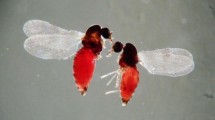Abstract
The water-filled tree hole fauna of biting midges (Diptera: Ceratopogonidae) in Slovakia is documented for the first time. Three Culicoides Latreille and two Dasyhelea Kieffer species were reared from these habitats. Epidemiological significance of C. obsoletus (Meigen, 1818) is briefly discussed.
Similar content being viewed by others
References
Braverman, Y., Messaddeq N., Lemble C., & Kremer M. (1996). Reevaluation of the taxonomic status of the Culicoides spp. (Diptera: Ceratopogonidae) from Israel and the eastern Mediterranean and review of their potential medical and veterinary importance. Journal of the American Mosquito Control Association 12: 437–445.
Callot, J., & Kremer M. (1961). Scission de l’espèce Culicoides truncorum Edwards (Diptera: Ceratopogonidae) en deux espèces. Bulletin de la Société de Pathologie Exotique 54: 389–398.
Carpenter, S., McArthur C., Selby R., Ward R., Nolan D.V., Mordue Luntz A.J., Dallas J.F., Tripet F., & Mellor P.S. (2008). Experimental infection studies of UK Culicoides species midges with bluetongue virus serotypes 8 and 9. Veterinary Record 163: 589–592. DOI:10.1136/vr.163.20.589
Disney, R.H.L. (1975). A midge (Diptera, Ceratopogonidae) new to Britain that is abundant in the limestone pavement of the Yorkshire Pennines. Entomologist’s Monthly Magazine 110: 227–228.
Disney, R.H.L., & Wirth W.W. (1982). A midge (Dipt., Ceratopogonidae) new to Britain from teasel axil-waters in Suffolk. Entomologist’s Monthly Magazine 118: 233–234.
Dominiak, P. (2012). Biting midges of the genus Dasyhelea Kieffer (Diptera: Ceratopogonidae) in Poland. Polish Journal of Entomology 81: 211–304. DOI: 10.2478/v10200-012-0009-8
Dominiak, P., & Szadziewski R. (2010). Distribution and new synonymy in European biting midges of the genus Dasyhelea Kieffer (Diptera: Ceratopogonidae). Zootaxa 2437: 1–37.
Dzhafarov, S.M. (1964). Blood-sucking midges (Diptera, Heleidae) of Transcaucasus (Morphology, biology, ecology, geographical distribution, harmfulness, control, and fauna of the genera Culicoides, Leptoconops and Lasiohelea). Baku: Akademija Nauk Azerbaidzanskoi SSR. (In Russian)
Edwards, F.W., Oldroyd H., & Smart J. (1939). British blood-sucking flies. London: British Museum.
Elbers, A.R.W., Meiswinkel R., van Weezep E., Sloet van Oldruitenborgh-Oosterbaan M.M., & Kooi E.A. (2013). Schmallenberg virus in Culicoides spp. biting midges, the Netherlands, 2011. Emerging Infectious Diseases 19: 106–109. DOI: 10.3201/eid1901.121054
Glukhova, V.M. (1979). Lichinki mokretsov podsemeistv Palpomyiinae i Ceratopogoninae fauny SSSR (Diptera, Ceratopogonidae=Heleidae). Opredeliteli po faune SSSR, izdavaemye Zoologicheskim Institutom AN SSSR. Volume 121. Leningrad: Nauka. (In Russian)
Gutsevich, A.V. (1973). The bloodsucking midges (Ceratopogonidae). Fauna SSSR. 3(5). Leningrad: Nauka. (In Russian)
Kitching, R.L. (2004). Food webs and container habitats: the natural history and ecology of phytotelmata. Cambridge: Cambridge University Press.
Lassen, S.B., Nielsen S.A., Skovgård H., & Kristensen M. (2011). Molecular identification of bloodmeals from biting midges (Diptera: Ceratopogonidae: Culicoides Latreille) in Denmark. Parasitology Research 108: 823–829.OI10.1007/s00436-010-2123-4
Linley, J.R. (1985). Biting midges (Diptera: Ceratopogonidae) as vectors of non-viral animal pathogens. Journal of Medical Entomology 22: 589–599.
Mellor, P.S., Booman J., & Baylis M. (2000). Culicoides biting midges: their role as arbovirus vectors. Annual Review of Entomology 45: 307–340. DOI: 10.1146/annurev.ento.45.1.307.
Mellor, P.S., & Pitzolis G. (1979): Observations on breeding sites and light-trap collections of Culicoides during an outbreak of bluetongue in Cyprus. Bulletin of Entomological Research 69: 229–234. DOI:10.1017/S0007485300017697
Mullen, G.R., & Hribar L.J. (1988). Biology and feeding behavior of ceratopogonid larvae (Diptera: Ceratopogonidae) in North America. Bulletin of the Society for Vector Ecology 13: 60–81.
Oboňa, J., & Ježek J. (2013). First records of dendrolimnetic moth flies (Diptera: Psychodidae) from Slovakia. Klapalekiana 48: 279–287.
Oboňa, J., Pollet M., & Naglis S. (2012). First records of one genus and three species of long-legged flies (Diptera: Dolichopodidae) from Slovakia. Folia faunistica Slovaca 17(4): 357–360.
Oboňa, J., & Starý J. (2013). Description of the larva and pupa of Nasiternella regia Riedel, 1914 (Diptera: Pediciidae) from Slovakia, with notes on ecology and behavior. Biologia (Bratislava) 68: 345–350. DOI: 10.2478/s11756-013-0149-7
Országh, I. (1984). Ceratopogonidae. In J. Čepelák (Ed.), Diptera Slovenska I (Nematocera, Brachycera — Orthorrhapha) (pp. 65–74). Bratislava: Veda, vydavatel’stvo Slovenskej akadémie vied. DOI: 10.1002/mmnd.4800330114
Röhnert, U. (1950). Wassererfüllte Baumhöhlen und ihre Besiedlung. Ein Beitrag zur Fauna dendrolimnetica. Archiv für Hydrobiologie 44: 472–516.
Stloukal, E., & Grujbárová Z. (2013). Databáza lokalít pre mapovanie fauny na území Slovenska. Retrieved October 25, 2013, from http://www.dfs.sk
Szadziewski, R. (1985). A faunistic review of the Polish biting midges of the genus Culicoides (Diptera, Ceratopogonidae). Polish Journal of Entomology 55: 283–341.
Szadziewski, R., Borkent A. & Dominiak P. (2013). Fauna Europaea: Ceratopogonidae. In P Beuk & T. Pape (Eds), Fauna Europaea: Diptera, Nematocera. Fauna Europaea version 2.6. Retrieved October 25, 2013, from http://www.faunaeur.org.
Szadziewski, R., Dominiak P. 2006. New synonyms of European Ceratopogonidae (Diptera). Annales Zoologici 56: 139–146.
Tóthová, A., & Knoz J. (2009). Ceratopogonidae Newman, 1834. In L. Jedlička, M. Kúdela & V. Stloukalová (Eds), Checklist of Diptera of the Czech Republic and Slovakia. Electronic version 2. Retrieved October 25, 2013, from http://zoology.fns.uniba.sk/diptera2009.
Valkanov, A. (1941). Über das Auffinden von Anabiotischen Dipteren in Bulgarien. Godišnik na Sofijskija universitet 37: 201–205.
Votýpka, J., Synek P., & Svobodová M. (2009). Endophagy of biting midges attacking cavity-nesting birds. Medical and Veterinary Entomology 23: 277–280. DOI:10.1111/j.1365-2915.2009.00800.x
Wirth, W.W., & Marston N. (1968). A method for mounting small insects on microscope slides in Canada balsam. Annals of the Entomological Society of America 61: 783–784.
Zilahi-Sebess, G. (1931). Anabiotische Dipteren. Archiv für Hydrobiologie 23: 310–329.
Author information
Authors and Affiliations
Corresponding author
About this article
Cite this article
Oboňa, J., Dominiak, P. Biting midges (Diptera: Ceratopogonidae) in tree hole habitats in Slovakia. Ocean and Hydro 43, 61–65 (2014). https://doi.org/10.2478/s13545-014-0118-y
Received:
Accepted:
Published:
Issue Date:
DOI: https://doi.org/10.2478/s13545-014-0118-y




